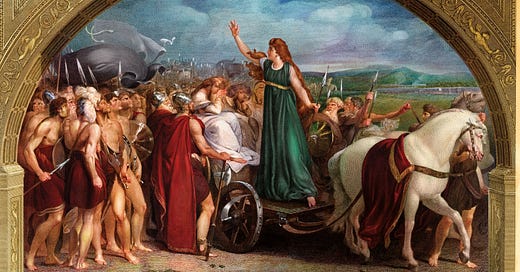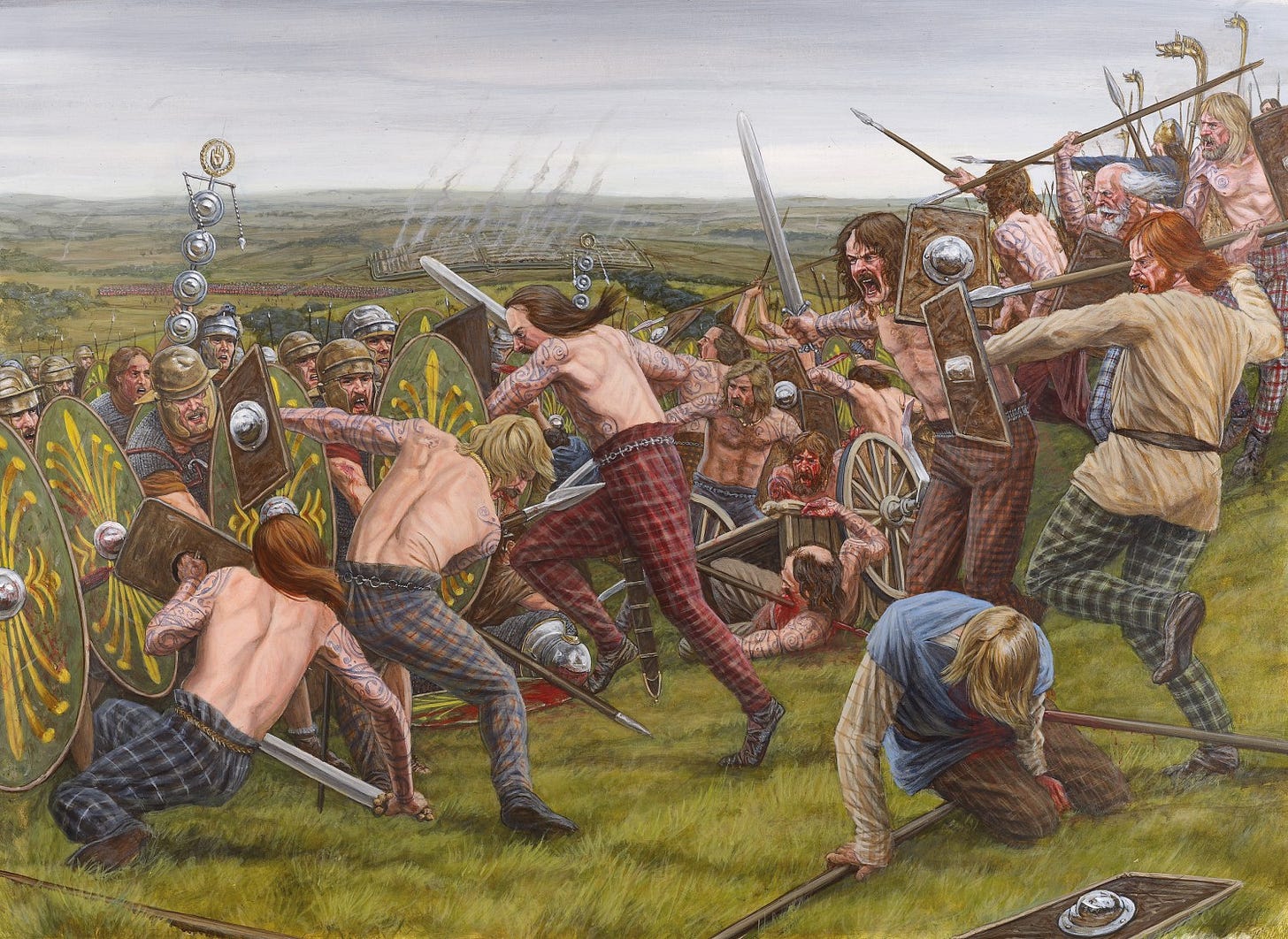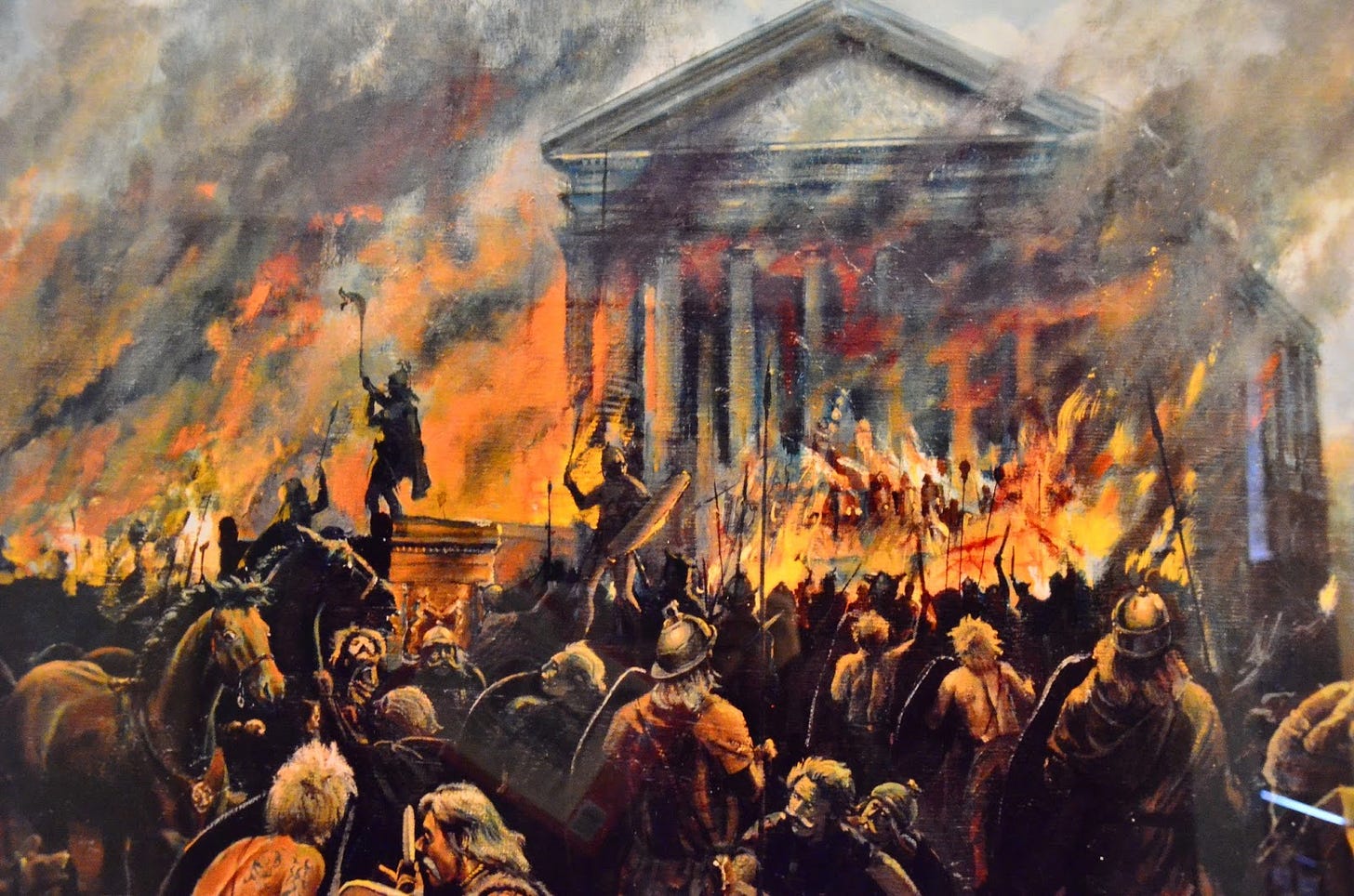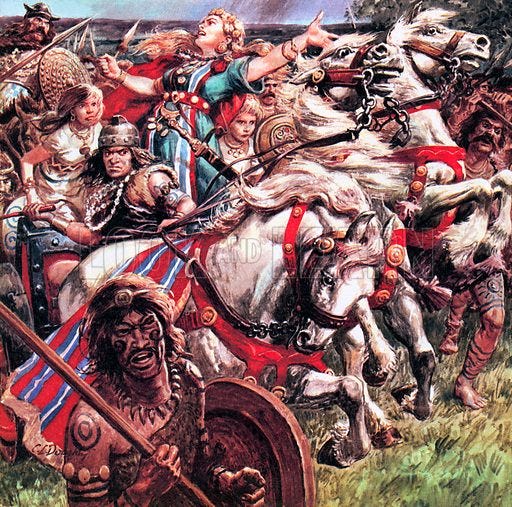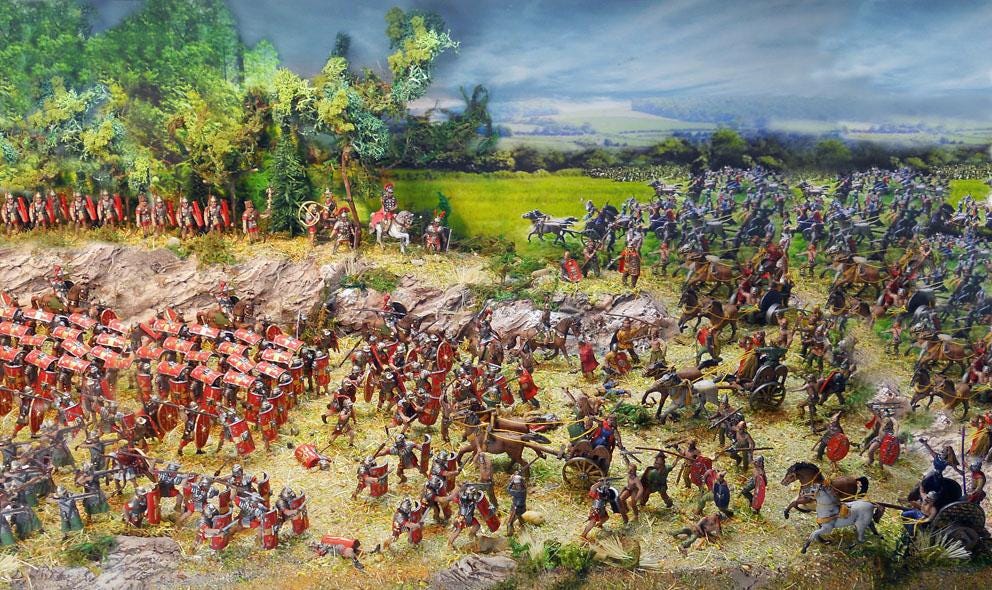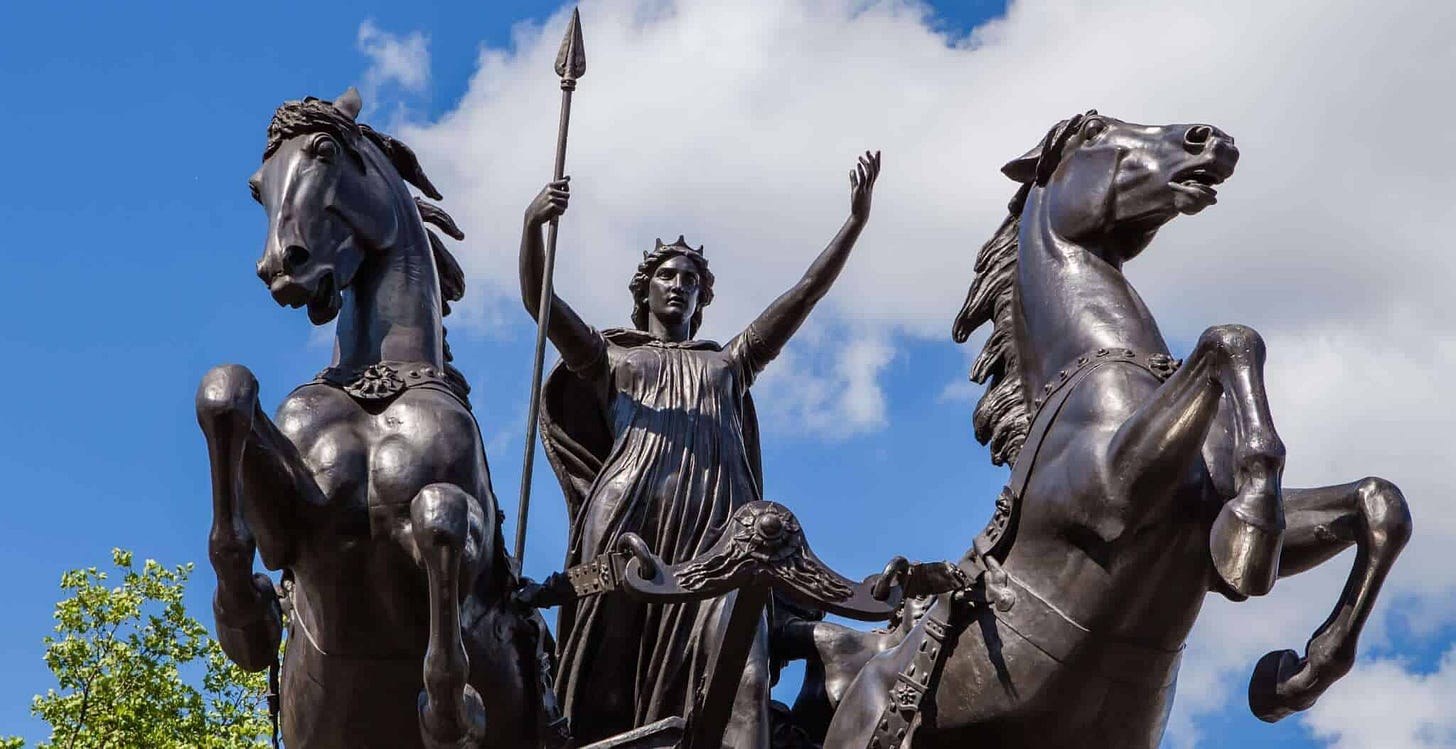Hello Dear Reader,
It is my exquisite honor to introduce to you today one of the most interesting Celtic figures of the ancient age. This will be a story of betrayal, justice and death. So, come dear reader, take a seat around my fire, blood has been been spilled and the Iceni howl with anguish and anger, wanting for Roman blood.
Long Live the Queen
Our story begins with the Iceni tribe, located in modern day Norfolk in Eastern England. The Iceni were a Celtic tribe that lived on the island long before the Romans did. Let me be clear, these were Celtic Britons, not Anglo-Saxons because, as we know, Anglo-Saxons did not come to the shores of Britain until after the Romans left in the 5th century.
The Iceni, at the time our story takes place, lived in the realm of Britain which held sway with the Romans. Now, dear reader, I know what you are thinking, Romans and native tribes do not usually exist peacefully together and in the end you would be correct. However, for the first decade or so of Roman rule on the island they existed peacefully. This is mainly due to the fact that the Iceni were a client state of Rome. A client state allows a ruler and their people to maintain a level of sovereignty as long as this client state did Rome’s bidding on chosen occasions.
The command of the tribe had first been under the leadership of Boudica’s husband Prasutagus. They had lived a supposedly quiet life and had two daughters. When Prasutagus had died he had left it in his will that his kingdom and people should be looked over by the Roman Empire as well as ruled by his two daughters. However, considering how empires work, I am sure you can guess that nothing of that sort would happen.
Nearly immediately after Prasutagus died, his lands were annexed and conquered by the Romans. To make matters worse, the Romans called in the loans they forced upon the Iceni many years ago. This was to give the Iceni an illusion that they had no choice but to submit to Roman rule. To add insult to injury, according to Tacitus (a Roman historian), Boudica and her daughters were also flogged and raped when the Romans took control.
It should be noted that most revolts in history are usually filled with intrigue or perhaps some small leader wanting greater power, however, the reasons for this revolt seem rather straight forward. Boudica wanted nothing but revenge and she would find it. In 60-61 AD, she tightens her brooch, takes up her spear and, grasping the reins of her chariot, rides out to war with an army of (supposedly) 230,000 at her back.
“Behold the Proud Display of Warlike Spirit”
This insult to her, her daughters, her land, and her people was unforgivable in the highest of fashions. So, it was not out of fashion that when Boudica and her tribe went on the warpath, it seems that there was not a proper plan besides this: lay waste to the Romans and to thier cities.
Boudica found an unlikely ally in the Trinovantes, a tribe grappling with their own grievances and losses. Together, fueled by shared mourning and a desire for retribution, they set their sights on Camulodunum, present-day Colchester. In a bold maneuver that caught the Romans off guard, Boudica orchestrated a devastating assault, achieving a resounding victory over Quintus Pettillius Cerialis, the commander of the Legio IX Hispana. The city of Camulodunum, was considered a Roman stronghold, but fell prey to the ferocity of the joint forces, succumbing to complete destruction. The Romans had placed too much confidence on their diplomatic ties and not enough in their military might.
After devastating Camulodunum, Boudica turned her attention to Londinium, the very nexus of Roman influence in Britannia. In a ruthless campaign, she razed Londinium to the ground, leaving nothing but smoldering ruins in her wake. The once-thriving Roman city became a symbol of resistance, its streets echoing with the cries of the aggrieved Iceni.
Boudica, fueled only by resentment against her Roman oppressors, showed no mercy to those who stood in her path. As her forces descended upon Londinium, any hope of clemency for the Roman inhabitants was crushed. Tacitus vividly captures the horror of the onslaught, noting that Boudica's forces took no prisoners. The very air in Londinium was thick with the acrid scent of destruction as the flames consumed everything in their path.
While Tacitus also claims the destruction of Verulamium, archaeological evidence remains inconclusive. However, the scars of Boudica's wrath are indelibly etched into the remnants of Camulodunum and Londinium. Dated burn marks on the archaeological record serve as haunting echoes of the rebellion, confirming the veracity of Tacitus' accounts.
“Just Give Me Britain”
In the end, Boudica and her forces would be defeated by the better organized and trained Roman forces. Suetonius would organize an attachment of 10,000 men against Boudica’s reported 230,000. Now, I would venture to say that these numbers were heavily inflated (or even deflated) to give the Romans an even greater victory as they overcame immense odds. Suetonius, to his credit, was in Wales, destroying a Druid site, at the time of the uprising. Upon hearing that Rome’s prized city on the island was in danger, he and his forces marched swiftly through the hostile country and made a stand on Watling Street.
The Roman forces, distinguished by superior tactics and equipment, held a decisive advantage over the native Celts. Battle-hardened and equipped with advanced shields and armor, the Romans adopted a wedge-shaped formation that enabled them to systematically advance upon the Celts. This formation, coupled with the deployment of cavalry, presented an insurmountable challenge for the primarily farmer-based Celtic forces, who were driven by a deep-seated fury at the perceived offenses committed against them. The cavalry, an element entirely unfamiliar to the Celts, further solidified the Roman advantage, as the Celts found themselves ill-equipped to counter this strategic and technological disparity.
As Tacitus vividly recounts, the Celtic army faced an unrelenting onslaught by Roman forces, resulting in a complete and devastating defeat with neither women nor horses being spared. Tacitus further reports that in a final act of defiance, Boudica took her own life, either through self-administered poison or succumbing to a mortal wound received in the thick of battle—historical ambiguity shrouding the circumstances of her demise.
The repercussions of Boudica's rebellion reverberated far beyond the smoldering ruins of Britannian cities. The Romans, shaken by the magnitude of their losses, were forced to confront not only the physical devastation but also the stark revelation of their political and military vulnerabilities on the island. In the crucible of rebellion, the weakness of their treaties and the inadequacy of their military presence became glaringly apparent. Their once-prized cities lay in ruin, and Rome had nearly lost control of the island in a swift and decisive blow.
The aftermath of Boudica's revolt extended beyond Britannia, casting a shadow over Rome's reputation across Europe. The rebellion served as a potent example to other tribes that resistance against Roman dominance was not only possible but could be met with a degree of success. The Romans, recognizing the peril such sentiments posed to their imperial ambitions, responded with a prolonged campaign of prosecution and persecution against the Iceni. The years following the rebellion were marked by Rome's relentless efforts to quell dissent, ensuring that the echoes of Boudica's revolt would not inspire further challenges to their authority.
Where Does This Leave Us?
Dear reader, you ask an excellent question. Firstly, the rebellion serves as a testament to the inherent challenges the Romans faced in making Britain a permanent bastion of their empire. The vast expanses of Roman territories demanded strategic allocation of resources, and the tumultuous frontier in Britannia strained their imperial reach. Boudica's revolt stands as a stark reminder that the isle, with its formidable resistance, would never be easily subdued.
Secondly, the rebellion casts a revealing light on the dynamics within Celtic society. While the Celts exhibit formidable individual prowess in battle, the difficulty of forming a cohesive defense or a united government is evident. This recurrent theme underscores the challenges faced by the Celts in consolidating their strength against external forces. The inability to forge a unified front could be both a strength and a weakness, as the Celts, though resilient fighters, struggled to present a collective front against the Roman incursion.
For the record, it should be noted that Tacitus was not actually there. He wrote about the rebellion years after. However, his father in law, Gnaeus Julius Agricola was. For those more familiar with Roman-British history you will be familiar with his name as he is responsible for conquest and excursions into Northern England, parts of Wales, and Southern Scotland. I still count him as a credible secondary source.
Dear readers, it appears our time together is drawing to a close, though I've thoroughly enjoyed it. The Romans have, once more, asserted their control over the frontier. Boudica may be long dead but she will forever remain a symbol of British independence. Join me in our next journey, where we delve into the saga of one of history's great ancient conquerors—a formidable figure from the East who marshals his army against all who dare to oppose him. Until next we meet.
-Flint
P.S.
To all my American and Canadian friends (although the Canadians had theirs a month earlier), I would like to wish you a very Happy Thanksgiving. May this holiday season be filled with warmth, gratitude, and joy in your shared moments with loved ones.

